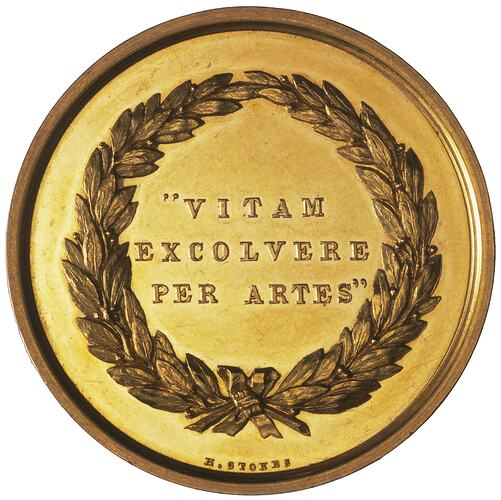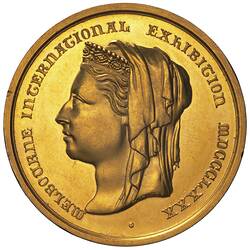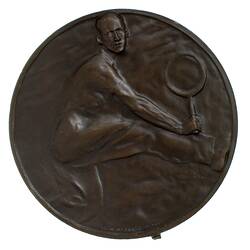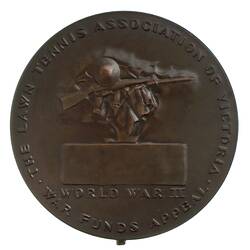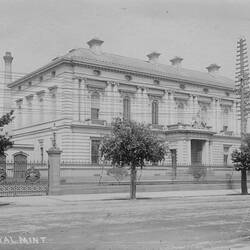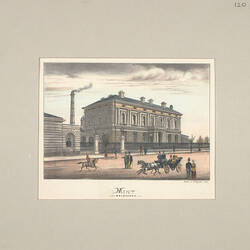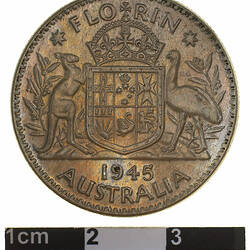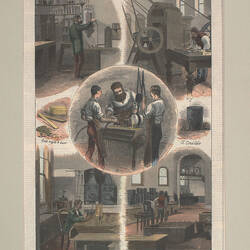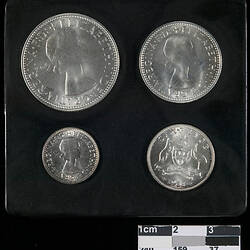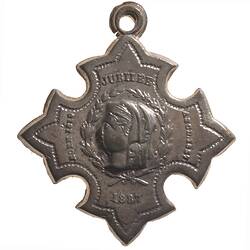Summary
Gold medal featuring a head of Queen Victoria, won by the British armaments firm Armstrong & Co. at the 1880 Melbourne International Exhibition (Jury Section XVIII - Weapons, etc. Official Record, p.320).
Armstrong had been established in 1847 by William G. Armstrong as an engineering works on Tynesid, the manufacturer was keen to develop international standing and to sell weapons to defence forces in the Australian Colonies. It entered an exhibit of 'war-like material' in the Melbourne International Exhibition in 1880, including a gun now held by Museum Victoria (ST 038282). The firm had previously won a gold medal at the Sydney exhibition in 1879 for the same exhibit. Armstrong eventually was merged several times, and today operates as Vickers Defence Systems.
The Melbourne International Exhibition ran from 1 October 1880 to 30 April 1881. The exhibition building that still stands was constructed for the occasion, designed by Joseph Reed and built by David Mitchell. Over 1.3 million people visited the exhibition at a time when Melbourne's population was only around 282,000. The Melbourne International Exhibition medals were actually made from gold unlike many 'gold' medals of the era, which were gold plated.
Physical Description
Gold medal featuring the head of Queen Victoria facing left, wearing coronet and veil. The reverse reatures a wreath enclosing an inscription.
Obverse Description
Veiled head of Queen Victoria left; around, MELBOURNE INTERNATIONAL EXHIBITION MDCCCLXXX .
Reverse Description
Within wreath, "VITAM / EXCOLVERE / PER ARTES" below wreath in small letters, H.STOKES
Edge Description
:SIR WILLIAM ARMSTRONG & Co. NEW-CASTLE-ON-TYNE _ WARLIKE MATERIAL
Significance
A competition for the design of a prize-winners medal for the 1880 Melbourne International Exhibition was arranged by the Exhibition Commission. A Committee was formed and a sketch produced to guide entrants to the competition. The competition was to be judged by V. Delves Broughton, Deputy Master of the Melbourne Mint, who would later oversee the actual production.
Broughton was not involved in the Committee's discussion about the preferred design, and was horrified when he saw the guide sketch that had been sent out to interested artists. The design was too complex (and, according to Broughton's correspondence, the relief too deep) to be produced. It appears he hastily wrote to each artist indicating that variations on the design were welcomed, and that the choce of winner would be based on which could be made from the thinnest guage of metal. He advised that the head of the Queen was unsuited to the task, and suggested that the Queen's head on the obverse of the Ashantee war medal by L.C. Wyon, featured in the Exhibition Catalogue, was a good model. Entrants were also directed to look at ancient medals and coins exhibited by the Mint.
The competition was won by Melbourne medallist and jeweller Ernst Altmann. The Melbourne Mint still rejected the design as too difficult to strike. Eventually a modified form of the Ashantee medal from the Sydney Mint presentation medal was used, combined with a simple reverse with wreath design entered by medallist Harry Stokes.
The medals were minted, and awarded in the folliwng manner. Gold, first prize with medal, for applications of new and useful principles, the production of useful machines, or great skill in manufacture, invention or design. Gold, second prize with certificate, for objects of art. Gold, third prize with certificate, for manufactures, products and industries of high merit. Silver and bronze medals were awarded for exhibits of lesser importance; silver and bronze level certificates were issued to lesser winners in each of these categories. -Sharples, John P. 1990. Medals as Art: Australia and the Meszaros tradition, p.16.
More Information
-
Collecting Areas
-
Acquisition Information
Purchase from Noble Numismatics, 11 Jul 1995
-
Date Issued
1880 AD
-
Issued By
-
Mint
Melbourne (Mint), 1880
Melbourne Branch of the Royal Mint -
Artist
-
Awarded To
-
Person Depicted
-
Inscriptions
Obverse: 'around, MELBOURNE INTERNATIONAL EXHIBITION MDCCCLXXX .' Reverse: within wreath, "VITAM / EXCOLVERE / PER ARTES'. Below wreath in small letters, 'H.STOKES'. Edge: ':SIR WILLIAM ARMSTRONG & Co. NEW-CASTLE-ON-TYNE _ WARLIKE MATERIAL'.
-
Series
-
Material
Gold
-
Axis
12
-
Classification
-
Category
-
Discipline
-
Type of item
-
Dimensions
39 mm (Outside Diameter), 51.212 g (Weight)
-
Exhibition Collection Management
38 mm (Outside Diameter)
-
Shape
Round
-
References
[Book] 1882. Official Record of the Melbourne International Exhibition 1880-1881.
-
Keywords
Defence Forces, Exhibitions, Exhibitions: Melbourne International, 1880-1881, Wars & Conflicts
